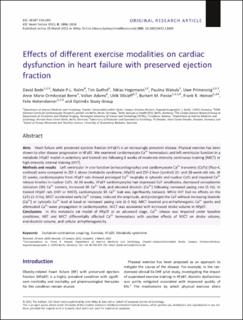| dc.contributor.author | Bode, David | |
| dc.contributor.author | Rolim, Natale Pinheiro Lage | |
| dc.contributor.author | Guthof, Tim | |
| dc.contributor.author | Hegemann, Niklas | |
| dc.contributor.author | Wakula, Paulina | |
| dc.contributor.author | Primessnig, Uwe | |
| dc.contributor.author | Berre, Anne Marie Ormbostad | |
| dc.contributor.author | Adams, Volker | |
| dc.contributor.author | Wisløff, Ulrik | |
| dc.contributor.author | Pieske, Burkert | |
| dc.contributor.author | Heinzel, Frank R. | |
| dc.contributor.author | Hohendanner, Felix | |
| dc.date.accessioned | 2023-01-12T10:13:33Z | |
| dc.date.available | 2023-01-12T10:13:33Z | |
| dc.date.created | 2021-12-01T12:23:36Z | |
| dc.date.issued | 2021 | |
| dc.identifier.citation | ESC Heart Failure. 2021, 8 (3), 1806-1818. | en_US |
| dc.identifier.issn | 2055-5822 | |
| dc.identifier.uri | https://hdl.handle.net/11250/3042943 | |
| dc.description.abstract | Aims
Heart failure with preserved ejection fraction (HFpEF) is an increasingly prevalent disease. Physical exercise has been shown to alter disease progression in HFpEF. We examined cardiomyocyte Ca2+ homeostasis and left ventricular function in a metabolic HFpEF model in sedentary and trained rats following 8 weeks of moderate-intensity continuous training (MICT) or high-intensity interval training (HIIT).
Methods and results
Left ventricular in vivo function (echocardiography) and cardiomyocyte Ca2+ transients (CaTs) (Fluo-4, confocal) were compared in ZSF-1 obese (metabolic syndrome, HFpEF) and ZSF-1 lean (control) 21- and 28-week-old rats. At 21 weeks, cardiomyocytes from HFpEF rats showed prolonged Ca2+ reuptake in cytosolic and nuclear CaTs and impaired Ca2+ release kinetics in nuclear CaTs. At 28 weeks, HFpEF cardiomyocytes had depressed CaT amplitudes, decreased sarcoplasmic reticulum (SR) Ca2+ content, increased SR Ca2+ leak, and elevated diastolic [Ca2+] following increased pacing rate (5 Hz). In trained HFpEF rats (HIIT or MICT), cardiomyocyte SR Ca2+ leak was significantly reduced. While HIIT had no effects on the CaTs (1–5 Hz), MICT accelerated early Ca2+ release, reduced the amplitude, and prolonged the CaT without increasing diastolic [Ca2+] or cytosolic Ca2+ load at basal or increased pacing rate (1–5 Hz). MICT lowered pro-arrhythmogenic Ca2+ sparks and attenuated Ca2+-wave propagation in cardiomyocytes. MICT was associated with increased stroke volume in HFpEF.
Conclusions
In this metabolic rat model of HFpEF at an advanced stage, Ca2+ release was impaired under baseline conditions. HIIT and MICT differentially affected Ca2+ homeostasis with positive effects of MICT on stroke volume, end-diastolic volume, and cellular arrhythmogenicity. | en_US |
| dc.language.iso | eng | en_US |
| dc.publisher | Wiley | en_US |
| dc.rights | Navngivelse-Ikkekommersiell 4.0 Internasjonal | * |
| dc.rights.uri | http://creativecommons.org/licenses/by-nc/4.0/deed.no | * |
| dc.title | Effects of different exercise modalities on cardiac dysfunction in heart failure with preserved ejection fraction | en_US |
| dc.title.alternative | Effects of different exercise modalities on cardiac dysfunction in heart failure with preserved ejection fraction | en_US |
| dc.type | Peer reviewed | en_US |
| dc.type | Journal article | en_US |
| dc.description.version | publishedVersion | en_US |
| dc.source.pagenumber | 1806-1818 | en_US |
| dc.source.volume | 8 | en_US |
| dc.source.journal | ESC Heart Failure | en_US |
| dc.source.issue | 3 | en_US |
| dc.identifier.doi | 10.1002/ehf2.13308 | |
| dc.identifier.cristin | 1962572 | |
| cristin.ispublished | true | |
| cristin.fulltext | original | |
| cristin.qualitycode | 1 | |

